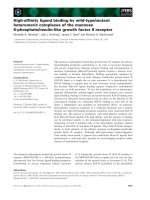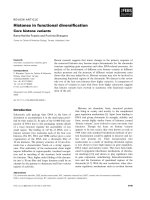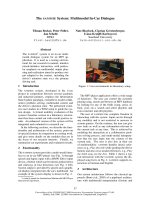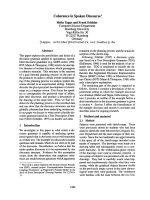Báo cáo khoa học: "Vasopressin in vasodilatory shock: ensure organ blood flow, but take care of the heart" ppsx
Bạn đang xem bản rút gọn của tài liệu. Xem và tải ngay bản đầy đủ của tài liệu tại đây (36.35 KB, 2 trang )
Page 1 of 2
(page number not for citation purposes)
Available online />Abstract
Supplementary arginine vasopressin infusion in advanced
vasodilatory shock may be accompanied by a decrease in cardiac
index and systemic oxygen transport capacity in approximately
40% of patients. While a reduction of cardiac output most
frequently occurs in patients with hyperdynamic circulation, it is
less often observed in patients with low cardiac index. Infusion of
inotropes, such as dobutamine, may be an effective strategy to
restore systemic blood flow. However, when administering
inotropic drugs, systemic blood flow should be increased to
adequately meet systemic demands (assessed by central or mixed
venous oxygen saturation) without putting an excessive beta-
adrenergic stress on the heart. Overcorrection of cardiac index to
hyperdynamic values with inotropes places myocardial oxygen
supply at significant risk.
In a previous issue of Critical Care, Ertmer and colleagues [1]
present an experimental study in which they examine the
effects of dobutamine when given together with arginine
vasopressin (AVP) in endotoxemic sheep. AVP is an
increasingly used supplementary vasopressor in advanced
vasodilatory shock states where standard treatment cannot
stabilize cardiovascular function with an acceptable
benefit:risk ratio. Due to its strong vasoconstrictive and lack
of beta-mimetic effects it was repeatedly shown to stabilize
hemodynamic function and result in beneficial cardiovascular
changes [2]. Preliminary results of a recently accomplished
multicenter trial including patients with septic shock suggest
a significant survival benefit at 28 and 90 days with a
supplementary AVP infusion when given to patients with
moderate cardiovascular failure (Congress of the European
Society of Intensive Care Medicine, Barcelona, September
24-27, 2006).
A potentially deleterious decrease in cardiac index (CI) during
AVP infusion was reported soon after the first results on the
use of AVP in septic shock had been published [3]. Whereas
animal experiments (mostly applying AVP as a single vaso-
pressor) homogeneously reported a decrease in CI and
systemic oxygen transport capacity (DO
2
I), clinical obser-
vations (applying AVP as a supplementary vasopressor)
showed heterogeneous responses, with most studies report-
ing neutral or even beneficial effects of AVP on cardiac
performance [2,4]. A recent analysis demonstrated a
decrease in CI during AVP infusion in 41% of vasodilatory
shock patients. High CI before AVP was the single
independent risk factor for a subsequent fall of CI. While
patients with hyperdynamic circulation exhibited a decrease
in CI to normodynamic values, patients with hypodynamic
circulation experienced a slight improvement of CI. Stroke
volume index increased irrespective of the circulatory state,
with the most pronounced increase in patients with
hypodynamic circulation [5].
In their present study, Ertmer and colleagues [1] evaluate
whether dobutamine can reverse an AVP-induced decrease
in CI and DO
2
I. The highly experienced working group used
an ovine endotoxinemic model, in which AVP has been shown
to depress CI and DO
2
I [6,7]. The authors’ conclusions are
fully supported by the results of their experiment and prove
that dobutamine is indeed a useful agent to reverse an AVP-
associated depression in CI and DO
2
I in this animal model.
When taking the results of this experimental study into clinical
practice, important limitations need to be considered. As
stated by the authors themselves, their protocol did not
analyze end organ perfusion and can, therefore, not prove if
the decrease in CI and DO
2
I resulted in organ hypoperfusion.
Moreover, AVP was applied as a single vasopressor at
dosages twice as high as recommended in clinical practice
(0.04 IU/minute in 35 kg sheep versus 0.04 IU/minute in
Commentary
Vasopressin in vasodilatory shock: ensure organ blood flow, but
take care of the heart!
Martin W Dünser
1
and Walter R Hasibeder
2
1
Department of Intensive Care Medicine, Inselspital Bern, Murtenstrasse, 3010 Bern, Switzerland
2
Department of Anesthesiology and Critical Care Medicine, Krankenhaus der Barmherzigen Schwestern, Ried im Innkreis, Austria
Corresponding author: Martin W Dünser,
Published: 22 November 2006 Critical Care 2006, 10:172 (doi:10.1186/cc5089)
This article is online at />© 2006 BioMed Central Ltd
See related research by Ertmer et al., />AVP = arginine vasopressin; CI = cardiac index; DO
2
I = systemic oxygen transport capacity; SVRI = systemic vascular resistance index.
Page 2 of 2
(page number not for citation purposes)
Critical Care Vol 10 No 6 Dünser and Hasibeder
70 kg patients). A small prospective study infusing high AVP
dosages has shown a highly different hemodynamic response
to AVP [8] than observed with standard recommended
dosages. Accordingly, the systemic vascular resistance index
(SVRI) during AVP infusion in this experimental study reached
supranormal values (approximately 2,000 dynes × m
2
×cm
-5
)
when compared to baseline values. This unphysiological
increase in SVRI could well explain a baroreceptor-mediated
(although possibly attenuated in endotoxemia [9]) decrease in
CI. The fact that in clinical practice SVRI is, at maximum,
increased to subnormal values by vasopressors, might be one
reason for the AVP-induced depression in CI in this experiment.
Nonetheless, this study underlines important points of hemo-
dynamic management in vasodilatory shock: Systemic blood
flow must be ensured to guarantee adequate organ perfusion
as reflected by central venous oxygen saturation >70% [10]
or mixed venous oxygen saturation >65% [11]. As shown by
the authors, inotropes such as dobutamine are a good choice
to reverse low systemic blood flow if preload optimization
cannot adequately increase CI. What must never be forgotten
when infusing inotropic agents and assessing adequate
organ perfusion is that, in critical illness, beta-adrenergic
stimulation has virtually no positive, but merely adverse
effects on the heart itself (exponential elevation of oxygen
demand due to increases in heart rate or triggering of
tachyarrhythmias, induction of myocardial stunning at high
dosages [12]). Recent data revealed that cardiac pathologies
made up almost 50% of the causes of death in patients with
advanced vasodilatory shock [5]. Considering the heart as
the obviously most vulnerable link of the cardiovascular chain,
it must be one of our goals to relieve the heart as much as
possible, while ‘enforcing’ as much systemic blood flow as
necessary for peripheral organs. A demand-based strategy
relying on central/mixed venous oxygen saturation is a very
useful tool to achieve this critical balance [10].
A putative mechanism by which supplementary AVP infusion
may exert beneficial effects is the significant reduction of high,
potentially toxic catecholamine dosages [13]. When reviewing
the results of Ertmer and colleagues, dobutamine did not only
restore hyperdynamic circulation, but also reversed potentially
beneficial effects of AVP on myocardial oxygen balance. As
shown in Figure 1 of the paper, the dobutamine-induced
increase in CI was accompanied by an increase in heart rate
from approximately 85 to 135 beats/minute. As cited by
Ertmer and collleagues, a recent study has shown an
alarmingly high incidence of major cardiac events (49%) in
high risk cardiac patients with tachycardia (>95 beats/
minutes for >12 hours) [14]. Finding the delicate balance
between pharmacological stress on the heart and adequate
organ perfusion is difficult but crucial to guarantee optimal
patient outcome in vasodilatory and septic shock.
Competing interests
The authors declare that they have no competing interests.
References
1. Ertmer C, Morelli A, Bone HG, Stubbe HD, Schepers R, Van
Aken H, Lange M, Borking K, Lucke M, Traber DL, Westphal M:
Dobutamine reverses the vasopressin-associated impair-
ment in cardiac index and systemic oxygen supply in ovine
endotoxemia. Crit Care 2006, 10:R144.
2. Mutlu GM, Factor P: Role of vasopressin in the management
of septic shock. Intensive Care Med 2004, 30:1276-1291.
3. Holmes CL, Walley KR, Chittock DR, Lehman T, Russell JA: The
effects of vasopressin on hemodynamics in severe septic
shock: a case series. Intensive Care Med 2001, 27:1416-1421.
4. Treschan TA, Peters J: The vasopressin system – physiology
and clinical strategies. Anesthesiology 2006, 105:599-612.
5. Luckner G, Dünser MW, Jochberger S, Mayr VD, Wenzel V,
Ulmer H, Schmid S, Knotzer H, Pajk W, Hasibeder W, et al.: Argi-
nine vasopressin in 316 patients with advanced vasodilatory
shock. Crit Care Med 2005, 33:2659-2666.
6. Westphal M, Stubbe H, Sielenkämper AW, Ball C, Van Aken H,
Borgulya R, Bone HG: Effects of titrated arginine vasopressin
on hemodynamic variables and oxygen transport in healthy
and endotoxemic sheep. Crit Care Med 2003, 31:1502-1508.
7. Westphal M, Freise H, Kehrel BE, Bone HG, Van Aken H, Sie-
lenkämper AW: Arginine vasopressin compromises gut
mucosal microcirculation in septic rats. Crit Care Med 2004,
32:194-200.
8. Klinzing S, Simon M, Reinhard K, Bredle DL, Meier-Hellmann A:
High-dose vasopressin is not superior to norepinephrine in
septic shock. Crit Care Med 2003, 31:2646-2650.
9. Schmidt HB, Werdan K, Müller-Werdan U: Autonomic dysfunc-
tion in the ICU patient. Curr Opin Crit Care 2001, 7:314-322.
10. Rivers E, Nguyen B, Havstad S, Ressler J, Muzzin A, Knoblich B,
Peterson E, Tomlanovich M; Early Goal Directed Therapy Collabo-
rative Group: Early goal-directed therapy in the treatment of
severe sepsis and septic shock. N Engl J Med 2001, 345:
1368-1377.
11. Heiselman D, Jones J, Cannon L: Continuous monitoring of
mixed venous oxygen saturation in septic shock. J Clin Monit
1986, 2:237-245.
12. Wittstein IS, Thiemann DR, Lima JA, Baughman KL, Schulman
SP, Gerstenblith G, Wu KC, Rade JJ, Bivalacqua TJ, Champion
HC: Neurohumoral features of myocardial stunning due to
sudden emotional stress. N Engl J Med 2005, 352:539-548.
13. Dünser MW, Hasibeder WR: Dear vasopressin, where is your
place in septic shock? Crit Care 2005, 9:134-135.
14. Sander O, Welters ID, Foex P, Sear JW: Impact of prolonged
elevated heart rate on incidence of major cardiac events in
critically ill patients with a high risk of cardiac complications.
Crit Care Med 2005, 33:81-88.









